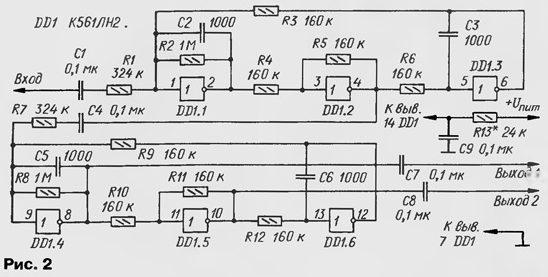
|
|
ENCYCLOPEDIA OF RADIO ELECTRONICS AND ELECTRICAL ENGINEERING Band pass filter on CMOS inverters. Encyclopedia of radio electronics and electrical engineering
Encyclopedia of radio electronics and electrical engineering / Radio amateur designer Active band-pass filters have significant advantages over passive ones, especially at low frequencies, since they make it possible to abandon coils that are large in this frequency region and are far from ideal in many other characteristics. An active biquad filter has high stability and stability, which makes it possible to obtain a quality factor exceeding 100 in the band-pass filter mode. A typical circuit of such a filter, built on operational amplifiers, is shown in fig. 1.
In a biquad filter, the summing integrator subtracts the output voltage of the low-pass filter from the input (they are out of phase by 180 degrees). - At a frequency below the transition section, these signals cancel each other out and the output signal is significantly attenuated. When it, increasing, enters the transition section, the decreasing output signal of the integrator no longer compensates for the input, so the signal level at the filter output increases. With a further increase in frequency, the rolloff of the frequency response of the integrator provides attenuation of the output signal and completes the formation of the frequency response of the bandpass filter. The disadvantage of the biquad filter is the increased number of active elements. Promising under these conditions can be considered the use of CMOS inverters as active elements, which can operate in a linear mode and have a number of advantages over operational amplifiers, for example, the absence of a tendency to self-excitation and an increased operating frequency. And the cost is usually lower. Among the shortcomings of the considered active elements, we note their small amplification (30 ... 50 dB). However, given that biquad filters do not have high gain requirements, this disadvantage is not an obstacle to the use of CMOS inverters as active elements. One of the most common microcircuits of the CMOS structure - K561LN2 - contains six inverters in one package, which makes it possible to build a fourth-order band-pass filter. A circuit of such a filter, obtained by cascading two second-order filters, is shown in Fig. 2.
It is easy to see that both second-order filters are identical and are similar in structure to a typical op-amp filter (see Fig. 1). The filter has two outputs, the signals on which are antiphase. The current consumed by the filter is set by selecting the resistor R13. In this case, the supply voltage can vary within 5 ... 15 V. With a decrease in the supply current, the gain of the active filter elements increases, but their frequency properties deteriorate and the output impedance increases. The current consumption should be considered optimal in the range of 0,5 ... 2 mA. With the ratings indicated on the diagram, the filter has a central frequency fo=1000 Hz, a bandwidth Δf=100 Hz, a transmission coefficient Кп=10. For other parameters, the filter can be calculated using the following method. Let us set for the input link С2=C3=С and R3=R4=R5=R. Calculate R, R1 and R2: R=1/(2πf0∙C); R1=Q/(2π∙f0∙C)∙√Kp; R2=Q/(2πf0∙C); Q=f0/Δf', where Δf'=Δf/v2-n, where Q is the quality factor of the filter; n is the number of cascaded links of the second order. The filter allows independent adjustment of parameters, if necessary. So, the central frequency fo of the input link can be adjusted by selecting the resistor R3, the quality factor Q - R2, the transfer coefficient Kp - R1. The operating frequency of the filter built on the inverters of the K561LN2 chip can reach hundreds of kilohertz. The use of similar microcircuits of the KR1564, 74AC, 74NS series will increase the operating frequency by 10...15 times. One of the features of the considered filter is that the bandwidth remains unchanged when the center frequency changes. In addition, when R1=R3, the link gain is determined by the ratio R2/R1. The input resistance of the link is more than the resistance of the resistor R1, the output is 10 ... 15 kOhm. The final amplification of the active elements can lead to some increase in the quality factor compared to the calculated value. The prototyping results confirmed the ease of filter adjustment, good agreement between the real characteristics and the calculated ones, and their high stability. Literature Folkenbury L. The use of operational amplifiers and linear ICs (translated from English). - M. Mir, 1986, 598 p. Author: D.Onyshko, Novocherkassk, Rostov Region.
Machine for thinning flowers in gardens
02.05.2024 Advanced Infrared Microscope
02.05.2024 Air trap for insects
01.05.2024
▪ Mussels helped create a super-strong polymer ▪ Artificial intelligence will be able to approach the capabilities of the human brain ▪ Short-lived plant species are more climate sensitive ▪ Among the bees, there are also right-handers and left-handers
▪ site section Regulators of current, voltage, power. Article selection ▪ article by Lucian of Samosata. Famous aphorisms ▪ article What holiday decorations were originally sweet and edible? Detailed answer ▪ article Framer. Standard instruction on labor protection ▪ article Liquid glue Syndeticon. Simple recipes and tips
Home page | Library | Articles | Website map | Site Reviews www.diagram.com.ua |






 Arabic
Arabic Bengali
Bengali Chinese
Chinese English
English French
French German
German Hebrew
Hebrew Hindi
Hindi Italian
Italian Japanese
Japanese Korean
Korean Malay
Malay Polish
Polish Portuguese
Portuguese Spanish
Spanish Turkish
Turkish Ukrainian
Ukrainian Vietnamese
Vietnamese


 Leave your comment on this article:
Leave your comment on this article: